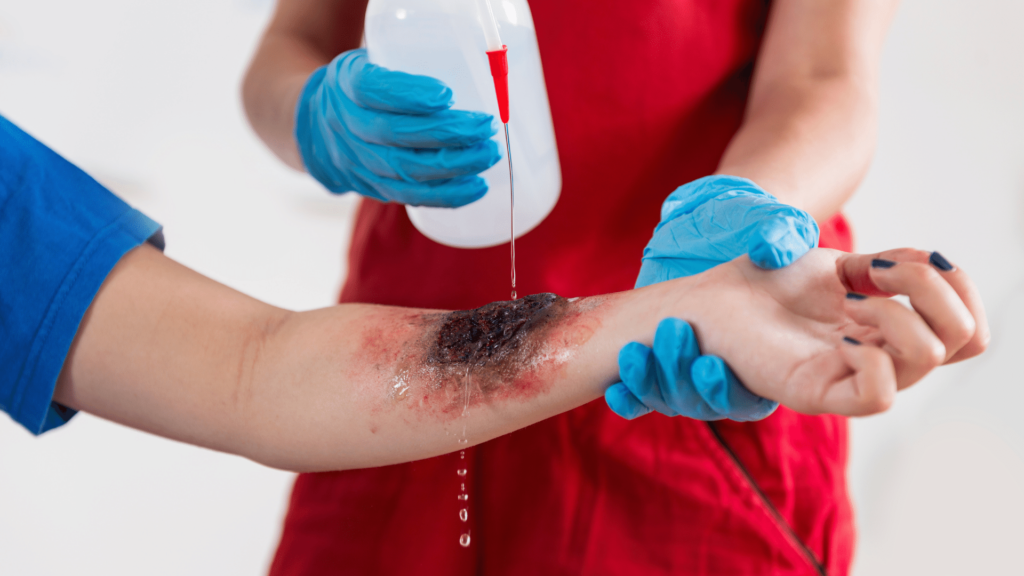Electricity is an essential part of our lives today; it powers our homes, offices, education, and devices. While making our lives easier, it also brings risks with it. One of these is Electic Burns. Electric Burns require immediate and appropriate first aid and care to minimize damage and promote rapid recovery. In this post, we have laid out the basics and provided the necessary first aid for electric burns to help you respond effectively in an emergency.
Understanding Electric Shock
When a person comes into direct contact with an electric current, such as touching a live electrical circuit or by being struck by lightning, it causes the formation and completion of a circuit, which results in an electric shock. The degree of an electric shock depends on various factors, such as electric potential, voltage, and the duration of exposure. In the event of discovering a person suffering an electric shock, the following should be done:
Intervene Immediately
If the person is still in contact with the object shocking them, it is important to break that contact using any insulated material. The circuit has to be broken to stop the electric current from flowing through the victim’s body and stop the shock. It should be done as soon as possible if the victim is still in contact with the object shocking them. This is because it minimizes the damage caused by electric shock to the victim and also the severity of any electric burns as a result of that shock.
Stay Safe
The safety of victims and rescuers is very important. Before helping, make sure the electricity is off or the victim is not touching them. Move the victim away from the power source using a non-conductive object such as a dry stick. It is also important to be aware of your own surroundings and to ensure you are properly equipped to intervene.
Get Help
After breaking the contact of the victim to the object shocking them, ask them how they are feeling and inspect their body for electric burns. Depending on the severity of the shock, the victim might have lost consciousness. Call emergency services immediately, especially if the victim has lost consciousness. Advanced medical help is very important in this situation.
First Aid Care for Electric Burns
Electric Burns are one of the specific types of burns that require special considerations to be taken into account when providing first aid to someone who has suffered them. It is important to monitor the patient’s ABCs, as electricity and lightning can affect the heart. With electric burns, it’s important to call 911 immediately. If the person is still breathing and conscious, you can ask them how they are feeling. However, if the person is unconscious and not breathing, you need to ensure that the person is no longer in contact with the object that caused the shock, then initiate CPR.
The detailed process is described below:
If the person is still breathing and conscious, you can ask them how they are feeling. However, if the person is unconscious and not breathing, you need to ensure that the person is no longer in contact with the object that caused the shock, then initiate CPR.
The detailed process is described below:
Assessment of the Problem
Assess the burn quickly. Burns are divided into three levels, similar to other types of burns. First-degree burns are burns on the surface of the skin. They are not deep and do not affect anything below the epidermis. They only affect only the outer layer of skin. Second-degree burns affect the lower and lower layers of the skin, causing blisters. Third-degree burns penetrate deep tissue and often cause burning or whitening and hard skin.Protect Yourself
Always remember that personal safety is paramount. Before giving first aid, make sure you are safe by wearing non-material gloves. Do not touch the burned area directly. This is done to ensure that there is no transfer of any germs or further damage to the burned area.Do Not Use Ice
One of the common methods is to use ice on a burned area to cool it. However, unlike other burns, ice should not be used in electric burns. Ice can cause further damage to tissues. Use flowing cold water instead to cool the burn.Treating Burns
Place the affected area in cold water for 10-20 minutes. This will help reduce pain and prevent further aggravation of the burn. Do not use extremely cold water, as it may cause hypothermia.Remove Products that Apply Pressure
Clothing and accessories that apply pressure can cause the burn to worsen by hindering the blood flow and causing tissue damage. If possible, remove tight clothing or jewelry near the burn to prevent compression that may cause swelling. This is also something done specifically in the case of chemical burns.Cover with a Clean Cloth
After the burn has cooled, cover it with a sterile bandage or a clean cloth. Do not apply a band-aid directly to the burn. This may cause damage to the skin as band-aids have adhesives and the skin affected by burn is very sensitive.Pain Management
An electric burn can be very painful. Please refrain from touching the burnt area. Over-the-counter painkillers such as Ibuprofen or Acetaminophen can be used to reduce pain. Please consult your physician regarding the appropriate dosage and direction.Get Medical Treatment
Even if the burn seems minor, seeking medical treatment is recommended. Electric burns can cause internal injuries that are not immediately noticeable and can worsen if not treated as soon as possible. This is why it is very important to get properly diagnosed so that proper treatment can be timely provided.Questions About Your Course?
Our team is ready to help you with your questions. Don’t hesitate and contact us today.
Tips to Prevent Electric Burns
 The following tips will help prevent electrical burns:
The following tips will help prevent electrical burns:
- Keep electrical devices away from water.
- If the wire is frayed, repair or discard it.
- Turn off or cover electrical outlets if there are children at home.
Special Precautions when Caring for Burns
 Remember the following special precautions when caring for burns:
Remember the following special precautions when caring for burns:
- Ointments should not be used on burns with full or even partial thickness.
- It is very important that blisters should not be touched as they are a part of the skin’s natural cooling mechanism.
- Only use clean or sterile dressing to touch the burn.
- Do not use a cotton swab or rub any clothing on the burn.
First Aid for Electric Burns in a Nutshell
Electrical burns can be serious and require prompt and appropriate treatment. By taking immediate action and following these tips, you can minimize the effects of your burn and increase your chances of a successful recovery. But always remember that medical attention is very important and the first step in dealing with electrical burns should be to contact emergency services. Knowledge and preparation are crucial to providing effective first aid in an emergency.
Earn your Standard First Aid and CPR certification with Coast2Coast and learn how to provide first aid for electric burns efficiently.
Register for First Aid Training
Register today for a First Aid training course and learn how to deal with emergencies and keep your loved ones safe! Check out our facilities and book your spot now.




















